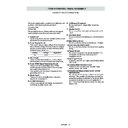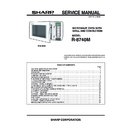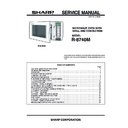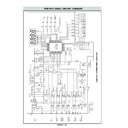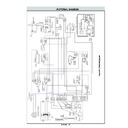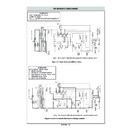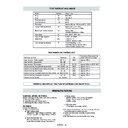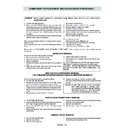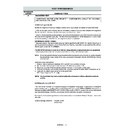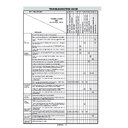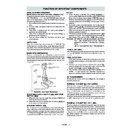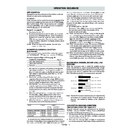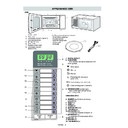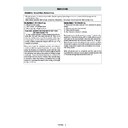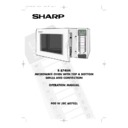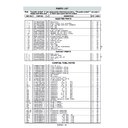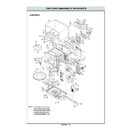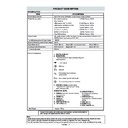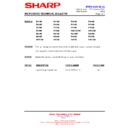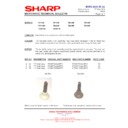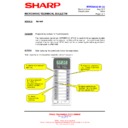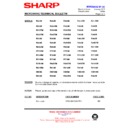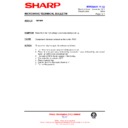Sharp R-8740 (serv.man9) Service Manual ▷ View online
R-8740M - 24
Pin No.
Signal
I/O
Description
ON/OFF time ratio in Micro
cooking
(a. 32second time base)
(a. 32second time base)
ON/OFF time ratio in Micro
cooking
(a. 48second time base)
cooking
(a. 48second time base)
MICRO
ON
OFF
COOK
100%
100%
32sec.
0sec.
70%
24sec.
8sec.
50%
18sec.
14sec.
30%
12sec.
20sec.
10%
6sec.
26sec.
MICRO
ON
OFF
COOK
100%
100%
48sec.
0sec.
70%
36sec.
12sec.
50%
26sec.
22sec.
30%
16sec.
32sec.
10%
8sec.
40sec.
19
P47
OUT
Grill heater (TOP HEATER) driving signal.
To turn on and off the grill heater relay
(RY3). "L" level during grill (TOP
GRILL, TOP AND BOTTOM) cooking
or dual (MICRO + TOP) cooking or
convection cooking. "H" level
otherwise.
To turn on and off the grill heater relay
(RY3). "L" level during grill (TOP
GRILL, TOP AND BOTTOM) cooking
or dual (MICRO + TOP) cooking or
convection cooking. "H" level
otherwise.
20
P46
OUT
Magnetron high-voltage circuit driving signal.
To turn on and off the cook
relay (RY2). In 100%
POWER operation, the
signals hold "L" level during
microwave cooking and "H"
level while not cooking. In
other cooking modes (70%,
50%, 30%, 10%) the signal
turns to "H" level and "L"
level in repetition according
to the power level.
To turn on and off the cook
relay (RY2). In 100%
POWER operation, the
signals hold "L" level during
microwave cooking and "H"
level while not cooking. In
other cooking modes (70%,
50%, 30%, 10%) the signal
turns to "H" level and "L"
level in repetition according
to the power level.
21
P45
OUT
Memory (I-2) clock output.
22
P44
IN/OUT
Memory (I-2) data input/output.
23
INT1
OUT
Terminal not used.
24
INT0
IN
Signal to synchronized LSI with commercial power source
frequency(50Hz).
This is basic timing for time processing of LSI.
frequency(50Hz).
This is basic timing for time processing of LSI.
25
P41
IN
Terminal not used.
26
P40
IN
Connected to VC.
27
RESET
IN
Auto clear terminal.
Signal is input to reset the LSI to the initial state when power is applied.
Temporarily set to "L" level the moment power is applied, at this time the LSI
is reset. Thereafter set at "H" level.
Signal is input to reset the LSI to the initial state when power is applied.
Temporarily set to "L" level the moment power is applied, at this time the LSI
is reset. Thereafter set at "H" level.
28-29
P71-P70
OUT
Terminal not used.
30
XIN
IN
Internal clock oscillation frequency input setting.
The internal clock frequency is set by inserting the ceramic filter oscillation
circuit with respect to XIN terminal.
The internal clock frequency is set by inserting the ceramic filter oscillation
circuit with respect to XIN terminal.
31
XOUT
OUT
Internal clock oscillation frequency control output.
Output to control oscillation input of XOUT.
Output to control oscillation input of XOUT.
32
VSS
IN
Power source voltage: -5V.
VC voltage of power source circuit input.
VC voltage of power source circuit input.
33-36
P27-P24
OUT
Terminal not used.
37
P23
IN
Signal coming from touch key.
When any one of G4 line keys on key matrix is touched, a corresponding
signal from P17 - P12 will be input into P23. When no key is touched, the
signal is held at "H" level.
When any one of G4 line keys on key matrix is touched, a corresponding
signal from P17 - P12 will be input into P23. When no key is touched, the
signal is held at "H" level.
38
P22
IN
Signal similar to P23.
When any one of G3 line keys on key matrix is touched, a corresponding
signal will be input into P22.
When any one of G3 line keys on key matrix is touched, a corresponding
signal will be input into P22.
39
P21
IN
Signal similar to P23.
When any one of G2 line keys on key matrix is touched, a corresponding
signal will be input into P21.
When any one of G2 line keys on key matrix is touched, a corresponding
signal will be input into P21.
40
P20
IN
Signal similar to P23.
When any one of G1 line keys on key matrix is touched, a corresponding
signal will be input into P20.
When any one of G1 line keys on key matrix is touched, a corresponding
signal will be input into P20.
DESCRIPTION OF LSI
LSI(IX091DR)
The I/O signal of the LSI(IX091DR) are detailed in the following table.
The I/O signal of the LSI(IX091DR) are detailed in the following table.
ON
OFF
During
cooking
L
GND
H.
(Grill,dual or convection)
20 msec
H : GND
L (-5V)
R-8740M - 25
Pin No.
Signal
I/O
Description
41
P17
OUT
Key strobe signal.
Signal applied to touch-key section. A pulse signal is input to P20 - P23
terminal while one of G5 line keys on matrix is touched.
Signal applied to touch-key section. A pulse signal is input to P20 - P23
terminal while one of G5 line keys on matrix is touched.
42
P16
OUT
Key strobe signal.
Signal applied to touch-key section. A pulse signal is input to P20 - P23
terminal while one of G6 line keys on matrix is touched.
Signal applied to touch-key section. A pulse signal is input to P20 - P23
terminal while one of G6 line keys on matrix is touched.
43
P15
OUT
Key strobe signal.
Signal applied to touch-key section. A pulse signal is input to P207 - P23
terminal while one of G7 line keys on matrix is touched.
Signal applied to touch-key section. A pulse signal is input to P207 - P23
terminal while one of G7 line keys on matrix is touched.
44
P14
OUT
Key strobe signal.
Signal applied to touch-key section. A pulse signal is input to P20 - P23
terminal while one of G8 line keys on matrix is touched.
Signal applied to touch-key section. A pulse signal is input to P20 - P23
terminal while one of G8 line keys on matrix is touched.
45
P13
OUT
Key strobe signal.
Signal applied to touch-key section. A pulse signal is input to P20 - P23
terminal while one of G9 line keys on matrix is touched.
Signal applied to touch-key section. A pulse signal is input to P20 - P23
terminal while one of G9 line keys on matrix is touched.
46
P12
OUT
Key strobe signal.
Signal applied to touch-key section. A pulse signal is input to P20 - P23
terminal while one of G10 line keys on matrix is touched.
Signal applied to touch-key section. A pulse signal is input to P20 - P23
terminal while one of G10 line keys on matrix is touched.
47-48
P11-P10
IN
Terminal not used.
49
P07
OUT
Cooking mode indicator driving signal.
To turn on and off the light emitting diode LD9.
To turn on and off the light emitting diode LD9.
50
P06
OUT
Cooking mode indicator driving signal.
To turn on and off the light emitting diode LD8.
To turn on and off the light emitting diode LD8.
51
P05
OUT
Cooking mode indicator driving signal.
To turn on and off the light emitting diode LD6.
To turn on and off the light emitting diode LD6.
52
P04
OUT
Cooking mode indicator driving signal.
To turn on and off the light emitting diode LD7.
To turn on and off the light emitting diode LD7.
53-56
P03-P00
OUT
Terminal not used.
57-60
P37-P34
OUT
Terminal not used.
61-72
SEG11-SEG0
OUT
Segment data signal.
Connected to LCD.
The relation between signals are as follows:
Connected to LCD.
The relation between signals are as follows:
LSI signal (Pin No.)
LCD (Pin No.)
LSI signal (Pin No.) LCD (Pin No.)
SEG 0 (72) .............................. S1
SEG 6 (66) ............................ S7
SEG 1 (71) .............................. S2
SEG 7 (65) ............................ S8
SEG 2 (70) .............................. S3
SEG 8 (64) ............................ S9
SEG 3 (69) .............................. S4
SEG 9 (63) .......................... S10
SEG 4 (68) .............................. S5
SEG10 (62) ......................... S11
SEG 5 (67) .............................. S6
SEG11 (61) ......................... S12
73/74
VCC/VREF
IN/IN
Connected to GND.
75
AVSS
IN
Connected to VC.
76
COM3
OUT
Terminal not used.
77
COM2
OUT
Common data signal: COM3.
Connected to LCD (Pin No. 3).
Connected to LCD (Pin No. 3).
78
COM1
OUT
Common data signal: COM2.
Connected to LCD (Pin No. 2).
Connected to LCD (Pin No. 2).
79
COM0
OUT
Common data signal: COM1.
Connected to LCD (Pin No. 1).
Connected to LCD (Pin No. 1).
80
VL3
IN
Power source voltage input terminal.
Standard voltage for LCD.
Standard voltage for LCD.
DESCRIPTION OF LSI
LSI(IX091DR)
The I/O signal of the LSI(IX091DR) are detailed in the following table.
The I/O signal of the LSI(IX091DR) are detailed in the following table.
R-8740M - 26
I-2 is a 2K-bit, serial memory, enabling CMOS to be erased/written electrically. This memory is constructed with
256 registers x 8bits, enabling individual access, read and write operations to be performed. Details of input/
output signal for I-2 are as shown in the following diagram.
256 registers x 8bits, enabling individual access, read and write operations to be performed. Details of input/
output signal for I-2 are as shown in the following diagram.
Table 2. Relation between Pin Nos, and Signals
Pin No.
Signal
I/O
Description
1-3
A0-A2
IN
Connected to +5V.
4
VSS
IN
Connected to GND.
5
SDA
IN/OUT
Serial data input/output : input/outputs data to I-1.
6
SCL
IN
Clock signal input : input/outputs serial data at every one pulse.
7
TEST
IN
Connected to GND.
8
VCC
IN
Connected to +5V.
Memory IC (I-2)
R-8740M - 27
SERVICING
Transistor
2SB1238
2SB1238
Transistor
DTA123ES
DTA143ES
DTD143ES
DTA123ES
DTA143ES
DTD143ES
For those models, check and repair all the controls
(sensor-related ones included) of the touch control
panel while keeping it connected to the oven.
(sensor-related ones included) of the touch control
panel while keeping it connected to the oven.
B. On some models, the power supply cord between
the touch control panel and the oven is long
enough that they may be separated from each
other. For those models, therefore, it is possible to
check and repair the controls of the touch control
panel while keeping it apart from the oven; in this
case you must short both ends of the door sensing
switch (on PWB) of the touch control panel with a
jumper, which brings about an operational state
that is equivalent to the oven door being closed. As
for the sensor-related controls of the touch control
panel, checking them is possible if the dummy
resistor(s) with resistance equal to that of the
controls are used.
enough that they may be separated from each
other. For those models, therefore, it is possible to
check and repair the controls of the touch control
panel while keeping it apart from the oven; in this
case you must short both ends of the door sensing
switch (on PWB) of the touch control panel with a
jumper, which brings about an operational state
that is equivalent to the oven door being closed. As
for the sensor-related controls of the touch control
panel, checking them is possible if the dummy
resistor(s) with resistance equal to that of the
controls are used.
(2) Servicing the touch control panel with power
supply from an external power source:
Disconnect the touch control panel completely from
the oven, and short both ends of the door sensing
switch (on PWB) of the touch control panel, which
brings about an operational state that is equivalent to
the oven door being closed. Connect an external
power source to the power input terminal of the touch
control panel, then it is possible to check and repair the
controls of the touch control panel; it is also possible to
check the sensor-related controls of the touch control
panel by using the dummy resistor(s).
Disconnect the touch control panel completely from
the oven, and short both ends of the door sensing
switch (on PWB) of the touch control panel, which
brings about an operational state that is equivalent to
the oven door being closed. Connect an external
power source to the power input terminal of the touch
control panel, then it is possible to check and repair the
controls of the touch control panel; it is also possible to
check the sensor-related controls of the touch control
panel by using the dummy resistor(s).
4. Servicing Tools
Tools required to service the touch control panel assembly.
1) Soldering iron: 30W
1) Soldering iron: 30W
(It is recommended to use a soldering iron with a
grounding terminal.)
grounding terminal.)
2) Oscilloscope: Single beam, frequency range: DC -
10MHz type or more advanced model.
3) Others: Hand tools
5. Other Precautions
1) Before turning on the power source of the control unit,
remove the aluminium foil applied for preventing static
electricity.
electricity.
2) Connect the connector of the key unit to the control unit
being sure that the lead wires are not twisted.
3) After aluminium foil is removed, be careful that abnormal
voltage due to static electricity etc. is not applied to the
input or output terminals.
input or output terminals.
4) Attach connectors, electrolytic capacitors, etc. to PWB,
making sure that all connections are tight.
5) Be sure to use specified components where high
precision is required.
1. Precautions for Handling Electronic Components
This unit uses CMOS LSI in the integral part of the circuits.
When handling these parts, the following precautions
should be strictly followed. CMOS LSI have extremely
high impedance at its input and output terminals. For this
reason, it is easily influenced by the surrounding high
voltage power source, static electricity charge in clothes,
etc., and sometimes it is not fully protected by the built-in
protection circuit.
In order to protect CMOS LSI.
1) When storing and transporting, thoroughly wrap them
When handling these parts, the following precautions
should be strictly followed. CMOS LSI have extremely
high impedance at its input and output terminals. For this
reason, it is easily influenced by the surrounding high
voltage power source, static electricity charge in clothes,
etc., and sometimes it is not fully protected by the built-in
protection circuit.
In order to protect CMOS LSI.
1) When storing and transporting, thoroughly wrap them
in aluminium foil. Also wrap PW boards containing
them in aluminium foil.
them in aluminium foil.
2) When soldering, ground the technician as shown in
the figure and use grounded soldering iron and work
table.
table.
2. Shapes of Electronic Components
3. Servicing of Touch Control Panel
We describe the procedures to permit servicing of the
touch control panel of the microwave oven and the
precautions you must take when doing so.
To perform the servicing, power to the touch control panel
is available either from the power line of the oven or from
an external power source.
touch control panel of the microwave oven and the
precautions you must take when doing so.
To perform the servicing, power to the touch control panel
is available either from the power line of the oven or from
an external power source.
(1) Servicing the touch control panel with power
supply of the oven :
CAUTION:
THE HIGH VOLTAGE TRANSFORMER OF THE
MICROWAVE OVEN IS STILL LIVE DURING SERV-
ICING AND PRESENTS A HAZARD .
THE HIGH VOLTAGE TRANSFORMER OF THE
MICROWAVE OVEN IS STILL LIVE DURING SERV-
ICING AND PRESENTS A HAZARD .
Therefore, when checking the performance of the
touch control panel, put the outer cabinet on the oven
to avoid touching the high voltage transformer, or
unplug the primary terminal (connector) of the high
voltage transformer to turn it off; the end of such
connector must be insulated with an insulating tape.
After servicing, be sure to replace the leads to their
original locations.
touch control panel, put the outer cabinet on the oven
to avoid touching the high voltage transformer, or
unplug the primary terminal (connector) of the high
voltage transformer to turn it off; the end of such
connector must be insulated with an insulating tape.
After servicing, be sure to replace the leads to their
original locations.
A. On some models, the power supply cord between
the touch control panel and the oven is so short that
the two can't be separated.
the two can't be separated.
approx. 1M ohm
E
C B
E
C
B
Display

